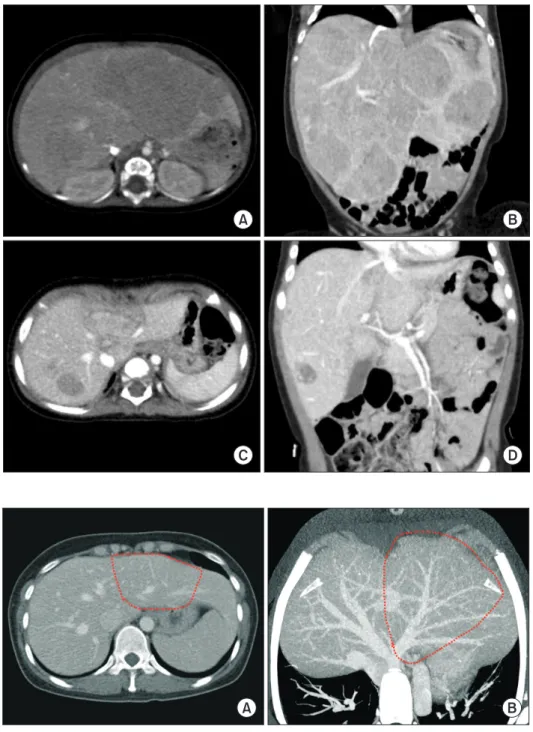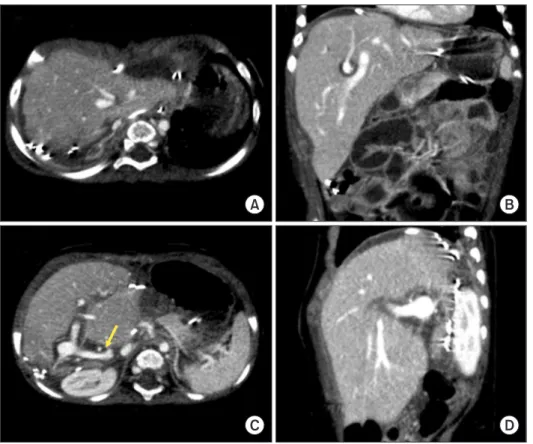AHBPS
Annals of Hepato-Biliary-Pancreatic SurgeryDextroplantation of a reduced left lateral section graft in an infant undergoing living donor liver transplantation
Jung-Man Namgoong
1, Shin Hwang
1, Gil-Chun Park
1, Kyung Mo Kim
2, Seak Hee Oh
2, Hyunhee Kwon
1, Yong Jae Kwon
11
Department of Surgery, Asan Medical Center, University of Ulsan College of Medicine, Seoul, Korea,
2
Department of Pediatrics, Asan Medical Center, University of Ulsan College of Medicine, Seoul, Korea
Case Report
Graft size matching is essential for successful liver transplantation in infant recipients. We present our technique of graft dextroplan- tation used in an infant who underwent living donor liver transplantation (LDLT) using a reduced left lateral section (LLS) graft. The patient was an 11-month-old female infant weighing 7.8 kg with hepatoblastoma. She was partially responsive to systemic chemother- apy. Thus, LDLT was performed to treat the tumor. The living donor was a 34-year-old mother of the patient. After non-anatomical size reduction, the weight of the reduced LLS graft was 235 g, with a graft-to-recipient weight ratio of 3.0%. Recipient hepatectomy was performed according to the standard procedures of pediatric LDLT. At the beginning of graft implantation, the graft was temporarily placed at the abdomen to determine the implantation location. The graft portal vein was anastomosed with an interposed external iliac vein homograft. As the liver graft was not too large and it was partially accommodated in the right subphrenic fossa, thus the ab- dominal wall wound was primarily closed. The patient recovered uneventfully. An imaging study revealed deep accommodation of the graft within the right subphrenic fossa. The patient has been doing well for six months without any vascular complications. This case suggests that dextroplantation of a reduced LLS graft can be a useful technical option for LDLT in infant patients.
Key Words: Infant; Large-for-size graft; Pediatric transplantation; Graft-recipient weight ratio; Left lateral segment
pISSN: 2508-5778ㆍeISSN: 2508-5859
Ann Hepatobiliary Pancreat Surg 2021;25:414-418 https://doi.org/10.14701/ahbps.2021.25.3.414
INTRODUCTION
In liver transplantation (LT) for infant patients, matching of the graft size to the recipient’s abdomen is critically import- ant because implantation of a large-for-size graft can induce various vascular complications and hinder primary closure of the abdomen. To overcome size mismatching in infants using adult partial liver grafts, several variants of left lateral section (LLS) grafts have been introduced [1-7]. Infant portal vein is usually much smaller than the vascular stumps of an adult LLS graft. In addition, during the posttransplant follow-up period, regeneration and rotation of the LLS graft towards the right
side can cause an additional issue for pediatric recipients as graft regeneration directs to the empty space on the right side [8,9]. Rotation to the right side of a left-sided graft can induce twist or compression of the graft’s vascular structures [9]. To prevent venous vascular complications in infant recipients, dextroplantation of a left liver graft as a unique technique has been recently introduced [9]. We have also developed the con- cept of dextroplantation technique of LLS grafts in pediatric recipients. However, our technique for graft dextroplantation is practically different from the abovementioned technique. We herein present our technique of graft dextroplantation used in an infant patient who underwent living donor liver transplan- tation (LDLT) with a reduced LLS graft.
CASE
The patient was a 11-month-old 7.8 kg-weighing female in- fant with hepatoblastoma. She was born at 39 weeks through normal full-term spontaneous delivery. At 7 months after birth, she started experiencing multiple vomiting. Thus, work- up studies were performed. Imaging studies and percutaneous liver biopsy confirmed the diagnosis of hepatoblastoma (Fig.
Received: January 10, 2021, Revised: January 19, 2021, Accepted: January 21, 2021
Corresponding author: Shin Hwang
Department of Surgery, Asan Medical Center, University of Ulsan College of Medicine, 88 Olympic-ro 43-gil, Songpa-gu, Seoul 05505, Korea
Tel: +82-2-3010-3930, Fax: +82-2-3010-6701, E-mail: shwang@amc.seoul.kr ORCID: https://orcid.org/0000-0002-9045-2531
Copyright Ⓒ The Korean Association of Hepato-Biliary-Pancreatic Surgery
This is an Open Access article distributed under the terms of the Creative Commons Attri- bution Non-Commercial License (http://creativecommons.org/licenses/by-nc/4.0) which permits unrestricted non-commercial use, distribution, and reproduction in any medium, provided the original work is properly cited.


